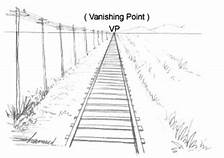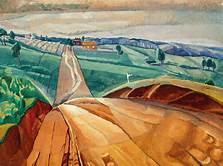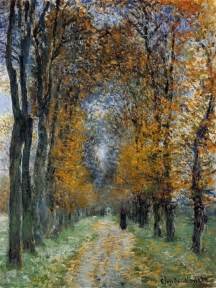Linear perspective, according to https://www.britannica.com/art/linear-perspective is ‘a system of creating an illusion of depth on a flat surface…with all parallel lines converging in a single vanishing point on the composition’s horizon line.
Linear perspective dates back to the Italian Renaissance when Brunelleschi, the Italian architect rediscovered the principal of linear perspective that was thought to have been used by the Greeks and Romans, although no records show this.


This illustration demonstrates the principles of linear perspective.
Artists use linear perspective to create the illusion of distance and depth in a drawing or painting.

In ‘Landscape at Pentecost’ by Grace Cossington Smith linear perspective is used to create a sense of distance. The dusty orange road leads to the distant hills of blue/purple. Although this painting demonstrates linear perspective as the road in the foreground stretches across the canvas and narrows to the vanishing point. It also demonstrates aerial perspective as the distant hills are less detailed and the colour changes.

The Avenue by claude Monet
In this painting, The Avenue by claude Monet, the vanishing point is located on the horizon line. The trees appear along lines that converge at the vanishing point. The trees closest to the vanishing point are smaller and appear closer together. We know that they do not meet but our eye leads us to believe they do. This creates a sense of depth in the painting.

Raphael’s School of Athens was painted using the principles of linear perspective. The first arch spans across the canvas. There is clear detail on ornamentation on the first archway. The second is considerably smaller, as are the people standing under it. The detail is fading which is how the eye would see it in reality. The coloured floor tiles shorten as they near the vanishing point. Beyond the third arch, which is very small, the illusion of depth is reinforced by the lack of clarity.

David Cox, English landscape painter uses linear perspective in his watercolour Poplar Avenue (c. 1820). The roadsides appear to meet on the horizon. We know that the roadsides don’t actually meet but we interpret them to converge. This creates a sense of distance. The figure on horseback draws our eye into the painting, down the road and off into the distance.
Atmospheric perspective can enhance the mood of a painting. The artist can control and manipulate the perspective
The artist can use aerial perspective to invite the viewer to engage with the painting.

This painting by Viktoria Prischedko is a winter landscape ‘Snowy Chathedral’ shows buildings that are less detailed of saurated with less detail in the background, with a figure walking towards the building leading the observer into the painting to try to fill in the missing information with their imagination.

J Trolinger Death Valley
How can such a perfectly peaceful looking place be called ‘Death Valley’? The artist creates atmospheric perspective using dark tones in the foreground and blue opaque hills with hints of lighter tone towards the bottom of the hills in the background.

Bethanne Kinsella Cople, “My Leaves and My Cascades”
I love this painting. It is very calming with the gentle rolling hills in the background, pine trees and the cool puddles in the foreground. The clouds are heavy and sit just above the damp landscape. Some of the tones in the sky can be seen in the distant hiss.

Contemporary landscape painting, “Field Guardian” by Carolee Clark, Philomath, Oregon Artist
I love the lines in this painting. It reminds me of the work of Paul Cezanne with the dark outlines and chunks of colour. The artist creates perspective by painting the trees in the background blues and lilacs and uses extremely pale tones to indicate trees and hills in the background.

The Seine at Giverny by Claude Monet
In this painting the tree hanging over the front left is detailed and is dark green in tone with white flowers. In the distance the trees gradually become less saturated and less detailed.
Some paintings benefit from linear perspective, aerial perspective or and both. Paintings that use one or the other, or indeed both, give the observer a sense of depth.